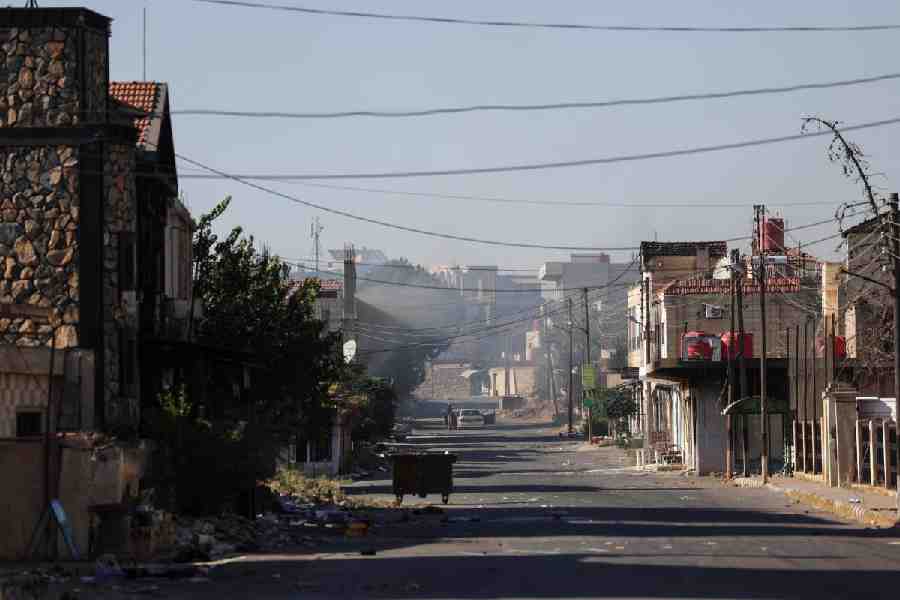 |
| Bhaskar Sen Gupta: ‘Solid’ support |
London, Aug. 29: A relatively simple and eco-friendly solution for tackling the lethal problem of arsenic present in drinking water as well as in rice and in fresh fruit and vegetables has been found by scientists, the lead team of researchers at Queen’s University Belfast has announced.
The project’s co-ordinator, Bhaskar Sen Gupta, 51, originally a chemical engineer from Jadavpur University, told The Telegraph today about the dramatic breakthrough: “The whole thing is so political that we did not want to go public with this until we were sure it worked — and now we are.”
Sen Gupta and his colleagues have set up six trial plants in and around Calcutta and are confident that they have devised a practical way of removing the arsenic by turning the soluble form into one that is solid.
Arsenic is a semi-metallic, naturally occurring chemical which is difficult to detect as it is odourless and flavourless. In Arab society, it ushered in “the golden age of poisoning”, while in Victorian England, it was popularly used in murder, especially by aggrieved ladies who wanted to get rid of tiresome husbands or two-timing lovers. It was a practice that British rulers took to India.
Today, it is essential to remove the arsenic in underground water that is said to be exposing, at least, 70 million people in Bengal, Bihar, Orissa and Bangladesh to cancer and other diseases. It is estimated that for every random sample of 100 people in the Bengal delta, at least one person will be near death as a result of arsenic poisoning, while five in 100 will experience other symptoms.
Queen’s University Belfast, which has formally claimed the breakthrough, has pointed out that the World Health Organisation (WHO) has cited the scale of this environmental disaster as greater than any seen before — it is described as even “beyond the accidents at Bhopal, India, in 1984 and Chernobyl, Ukraine, in 1986”.
WHO has emphasised: “Arsenic in drinking water is a major public health hazard and should be dealt with as an emergency.”
What is worrying is that the arsenic, which is swept down from the Himalayas and used to be deposited in silt on riverbanks, started becoming soluble between 30 and 40 years ago. Scientists say this is because the introduction of modern methods of intensive farming, using huge quantities of chemical fertilisers, upset the balance of nature.
However, according to Sen Gupta, the soluble arsenic is easily removed by pumping the water in tube-wells from a depth of 80-100ft and then spraying it above ground using the kind of shower heads found in bathrooms.
“The exposure to oxygen has the effect of precipitating the arsenic,” revealed Sen Gupta. “After a time lapse of a few hours, the water is sent back into the well. After a while, the arsenic drops below the hazardous level.”
The domestic water filters, used in thousands of homes in India, are not very efficient and can only deal with small quantities of water, said Sen Gupta. “Also, there is no way of knowing when they stop working. We need many, many, many treatment plants but each one can deal with 100 households.”
Of the six trial plants currently in operation, “one is at Kasimpur, 25km north of Calcutta airport; another at Basirhat, 100km from Calcutta near the Bangladesh border”.
In order to solve the problem, Sen Gupta had to go back to basics and understand how the arsenic came to be in the water in the first place.
“Arsenic is present in the mineral matters deposited in the form of silt by major rivers in West Bengal and Bangladesh,” he said. “The arsenic-bearing minerals exist in the shallow aquifer zones (up to 200ft) of the region.”
He went on: “One popular theory of the presence of arsenic in the aqueous phase is biochemical activity of soil bacteria, which uses arsenic-bearing minerals as a source of oxygen. Intensive agriculture that uses high quantities of fertiliser further accelerates the bacterial action. The dissolved form of arsenic is far more toxic than the mineral form, which is abundant in the subterranean zone of the Bengal delta.”
While researching the history of extracting underground water, Sen Gupta realised that a technique that had been used in Germany for well over a century to take out unwanted manganese and iron also removes the deadly arsenic.
Sen Gupta flew to Stuttgart and “at once realised that the precipitation process which removes the iron also precipitates the soluble arsenic. We did not have to invent something new.”
Sen Gupta, who has been based at Queen’s University Belfast for nearly eight years, starting commuting between Northern Ireland and Calcutta, “where I was born”.
“I am basically a chemical engineer,” he said. “I did my chemical engineering degree from Jadavpur, then my masters from the Indian Institute of Science in Bangalore.”
Before taking up his current post, he worked in industry in India and in Malaysia, where he also obtained his PhD. “At Queen’s University Belfast, I shifted from the department of chemical engineering to civil engineering where I am a senior lecturer in environmental engineering.”
The project is part of a EU-funded programme dedicated to the improvement of environmental performance in Asia. Known as TiPOT (Technology for in-situ treatment of groundwater for potable and irrigation purposes), a key element is the establishment of sustainable technology partnerships.
“The new plant will be maintained and operated by local village technicians,” said Sen Gupta. “To help apply the technology to other areas in the South Asian region, the World Bank has given a grant of $200,000 to set up six more subterranean water treatment plants in the Gangetic plains of West Bengal.”
Partners include the British Council, the Institute of Environmental Management and Studies, Jamshedpur, and Bengal Engineering and Science University.











